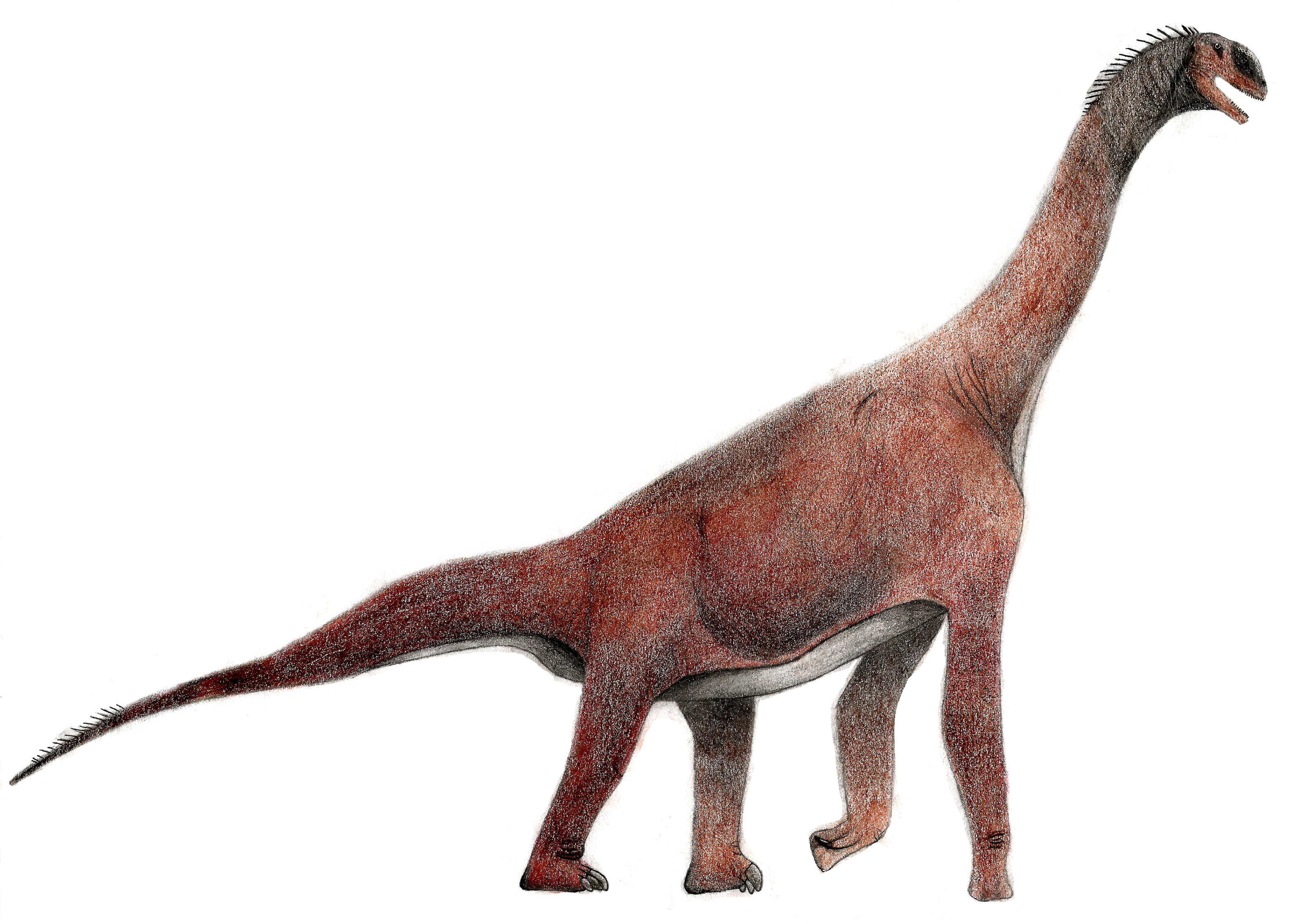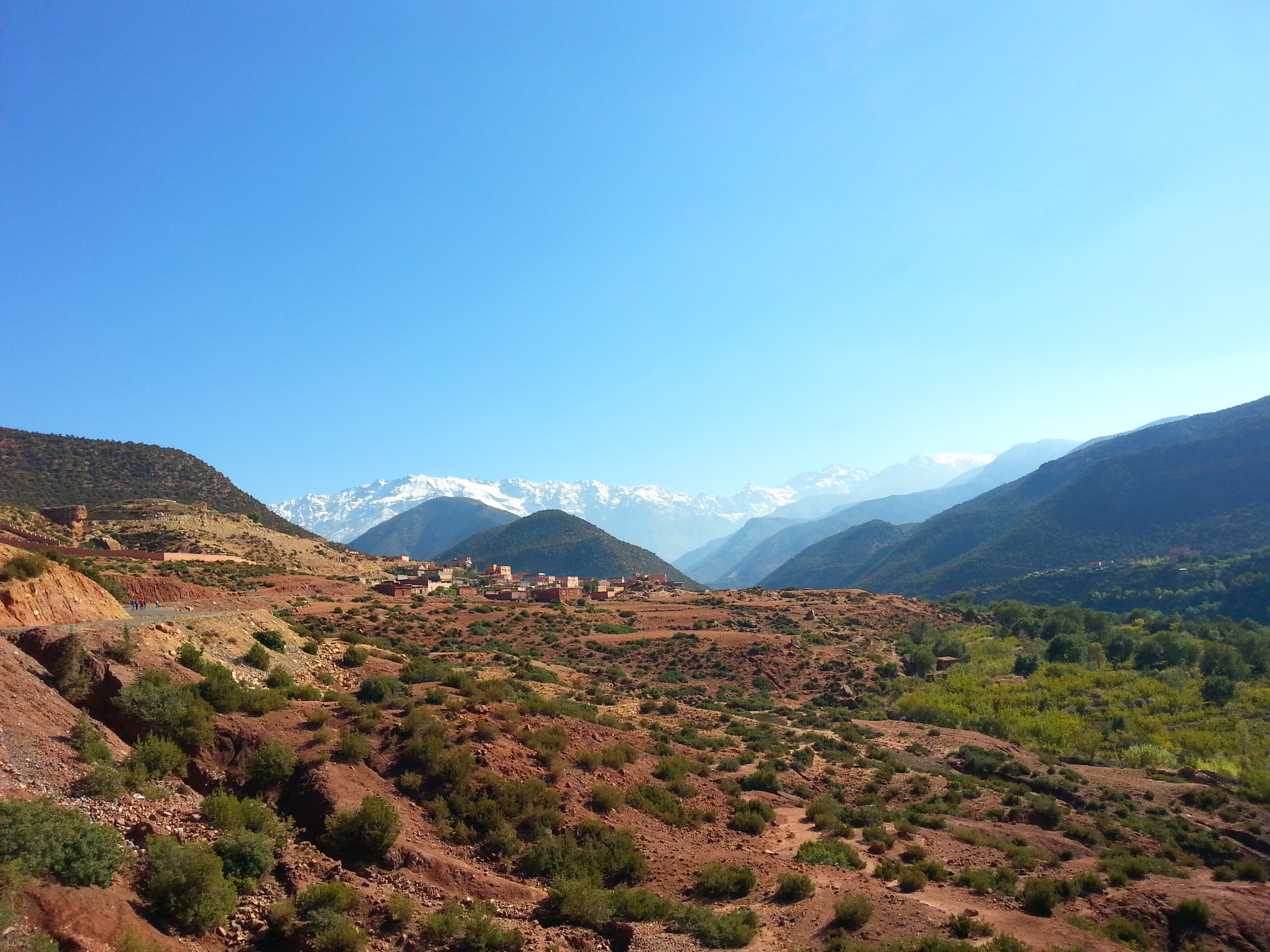|
Atlasaurus
''Atlasaurus'' is a genus of sauropod dinosaurs from Middle Jurassic (Bathonian to Callovian stages) beds in North Africa.M. Monbaron, D. A. Russell, and P. Taquet. (1999). ''Atlasaurus imelakei'' n.g., n.sp., a brachiosaurid-like sauropod from the Middle Jurassic of Morocco. ''Comptes Rendus de l'Académie des Sciences à Paris, Sciences de la Terre et des Planètes'' 329:519-526. Description ''Atlasaurus'' differs from ''Brachiosaurus'' relative to the estimated length of the dorsal vertebral column (assuming 12 vertebrae, ), in having a proportionately larger skull, a shorter neck (with at least 13 cervical vertebrae, shorter and more uniform in length than ''Brachiosaurus''), a longer tail and more elongated limbs (humerus to femur ratio: 0.99; ulna to tibia ratio: 1.15). The teeth are spoon-shaped and have denticles. The lower jaw of ''Atlasaurus'' is about long, the neck was about long, the humerus long, and the femur about long. It has been estimated at in length, a ... [...More Info...] [...Related Items...] OR: [Wikipedia] [Google] [Baidu] |
Atlasaurus
''Atlasaurus'' is a genus of sauropod dinosaurs from Middle Jurassic (Bathonian to Callovian stages) beds in North Africa.M. Monbaron, D. A. Russell, and P. Taquet. (1999). ''Atlasaurus imelakei'' n.g., n.sp., a brachiosaurid-like sauropod from the Middle Jurassic of Morocco. ''Comptes Rendus de l'Académie des Sciences à Paris, Sciences de la Terre et des Planètes'' 329:519-526. Description ''Atlasaurus'' differs from ''Brachiosaurus'' relative to the estimated length of the dorsal vertebral column (assuming 12 vertebrae, ), in having a proportionately larger skull, a shorter neck (with at least 13 cervical vertebrae, shorter and more uniform in length than ''Brachiosaurus''), a longer tail and more elongated limbs (humerus to femur ratio: 0.99; ulna to tibia ratio: 1.15). The teeth are spoon-shaped and have denticles. The lower jaw of ''Atlasaurus'' is about long, the neck was about long, the humerus long, and the femur about long. It has been estimated at in length, a ... [...More Info...] [...Related Items...] OR: [Wikipedia] [Google] [Baidu] |
High Atlas
High Atlas, also called the Grand Atlas ( ar, الأطلس الكبير, Al-Aṭlas al-Kabīr; french: Haut Atlas; shi, ⴰⴷⵔⴰⵔ ⵏ ⴷⵔⵏ ''Adrar n Dern''), is a mountain range in central Morocco, North Africa, the highest part of the Atlas Mountains. The High Atlas rises in the west at the Atlantic Ocean and stretches in an eastern direction to the Moroccan-Algerian border. At the Atlantic and to the southwest the range drops abruptly and makes an impressive transition to the coast and the Anti-Atlas range. To the north, in the direction of Marrakech, the range descends less abruptly. The range includes Jbel Toubkal, which at is the highest in the range and lies in Toubkal National Park. The range serves as a weather system barrier in Morocco running east–west and separating the Sahara from the Mediterranean and continental zones to the north and west. In the higher elevations of the massif, snow falls regularly, allowing winter sports. Snow lasts well into late ... [...More Info...] [...Related Items...] OR: [Wikipedia] [Google] [Baidu] |
Guettioua Formation
The Guettioua Formation is a geological formation in Morocco. It dates back to the Middle Jurassic.Weishampel, David B; et al. (2004). "Dinosaur distribution (Middle Jurassic, Africa)." In: Weishampel, David B.; Dodson, Peter; and Osmólska, Halszka (eds.): The Dinosauria, 2nd, Berkeley: University of California Press. Pp. 542-543. . It largely consists of sandstone, and is of continental origin. It is the lateral equivalent of the marine El Mers Formation. Vertebrate fauna See also * List of dinosaur-bearing rock formations This list of dinosaur-bearing rock formations is a list of geologic formations in which dinosaur fossils have been documented. Containing body fossils * List of stratigraphic units with dinosaur body fossils ** List of stratigraphic units with few ... References {{Reflist Geologic formations of Morocco Jurassic System of Africa Jurassic Morocco Bathonian Stage Sandstone formations Siltstone formations Marl formations Ichnofossiliferous formation ... [...More Info...] [...Related Items...] OR: [Wikipedia] [Google] [Baidu] |
Bathonian
In the geologic timescale the Bathonian is an age and stage of the Middle Jurassic. It lasted from approximately 168.3 Ma to around 166.1 Ma (million years ago). The Bathonian Age succeeds the Bajocian Age and precedes the Callovian Age. Stratigraphic definitions The Bathonian Stage takes its name from Bath, a spa town in England built on Jurassic limestone (the Latinized form of the town name is ''Bathonium''). The name was introduced in scientific literature by Belgian geologist d'Omalius d'Halloy in 1843. The original type locality was located near Bath. The French palaeontologist Alcide d'Orbigny was in 1852 the first to define the exact length of the stage. The base of the Bathonian is at the first appearance of ammonite species '' Parkinsonia (Gonolkites) convergens'' in the stratigraphic column. The global reference profile for the base of the Bathonian (a GSSP) was ratified as Ravin du Bès, Bas-Auran area, Alpes de Haute Provence, France in 2009. The top of the Bat ... [...More Info...] [...Related Items...] OR: [Wikipedia] [Google] [Baidu] |
Humerus
The humerus (; ) is a long bone in the arm that runs from the shoulder to the elbow. It connects the scapula and the two bones of the lower arm, the radius and ulna, and consists of three sections. The humeral upper extremity consists of a rounded head, a narrow neck, and two short processes (tubercles, sometimes called tuberosities). The body is cylindrical in its upper portion, and more prismatic below. The lower extremity consists of 2 epicondyles, 2 processes (trochlea & capitulum), and 3 fossae (radial fossa, coronoid fossa, and olecranon fossa). As well as its true anatomical neck, the constriction below the greater and lesser tubercles of the humerus is referred to as its surgical neck due to its tendency to fracture, thus often becoming the focus of surgeons. Etymology The word "humerus" is derived from la, humerus, umerus meaning upper arm, shoulder, and is linguistically related to Gothic ''ams'' shoulder and Greek ''ōmos''. Structure Upper extremity The upper or pr ... [...More Info...] [...Related Items...] OR: [Wikipedia] [Google] [Baidu] |
Mexico
Mexico (Spanish: México), officially the United Mexican States, is a country in the southern portion of North America. It is bordered to the north by the United States; to the south and west by the Pacific Ocean; to the southeast by Guatemala, Belize, and the Caribbean Sea; and to the east by the Gulf of Mexico. Mexico covers ,Mexico ''''. . making it the world's 13th-largest country by are ... [...More Info...] [...Related Items...] OR: [Wikipedia] [Google] [Baidu] |
Utah
Utah ( , ) is a state in the Mountain West subregion of the Western United States. Utah is a landlocked U.S. state bordered to its east by Colorado, to its northeast by Wyoming, to its north by Idaho, to its south by Arizona, and to its west by Nevada. Utah also touches a corner of New Mexico in the southeast. Of the fifty U.S. states, Utah is the 13th-largest by area; with a population over three million, it is the 30th-most-populous and 11th-least-densely populated. Urban development is mostly concentrated in two areas: the Wasatch Front in the north-central part of the state, which is home to roughly two-thirds of the population and includes the capital city, Salt Lake City; and Washington County in the southwest, with more than 180,000 residents. Most of the western half of Utah lies in the Great Basin. Utah has been inhabited for thousands of years by various indigenous groups such as the ancient Puebloans, Navajo and Ute. The Spanish were the first Europe ... [...More Info...] [...Related Items...] OR: [Wikipedia] [Google] [Baidu] |
Type Species
In zoological nomenclature, a type species (''species typica'') is the species name with which the name of a genus or subgenus is considered to be permanently taxonomically associated, i.e., the species that contains the biological type specimen(s). Article 67.1 A similar concept is used for suprageneric groups and called a type genus. In botanical nomenclature, these terms have no formal standing under the code of nomenclature, but are sometimes borrowed from zoological nomenclature. In botany, the type of a genus name is a specimen (or, rarely, an illustration) which is also the type of a species name. The species name that has that type can also be referred to as the type of the genus name. Names of genus and family ranks, the various subdivisions of those ranks, and some higher-rank names based on genus names, have such types. [...More Info...] [...Related Items...] OR: [Wikipedia] [Google] [Baidu] |
Azilal Province
{{BéniMellalKhénifra-geo-stub ...
Azilal (in berber : ⴰⵣⵉⵍⴰⵍ) is a province in the Moroccan region of Béni Mellal-Khénifra. Its population in 2004 is 504,501. The major cities and towns are: * Afourar * Azilal * Ait Attab * Bzou * Demnate * Foum Jamaa * Ouaouizeght Subdivisions The province is divided administratively into the following: References Azilal Province Azilal (in berber : ⴰⵣⵉⵍⴰⵍ) is a province in the Moroccan region of Béni Mellal-Khénifra. Its population in 2004 is 504,501. The major cities and towns are: * Afourar * Azilal * Ait Attab * Bzou Bzou (بزو) is a town in th ... [...More Info...] [...Related Items...] OR: [Wikipedia] [Google] [Baidu] |
Atlas (mythology)
In Greek mythology, Atlas (; grc-gre, Ἄτλας, ''Átlas'') is a Titan condemned to hold up the heavens or sky for eternity after the Titanomachy. Atlas also plays a role in the myths of two of the greatest Greek heroes: Heracles (Hercules in Roman mythology) and Perseus. According to the ancient Greek poet Hesiod, Atlas stood at the ends of the earth in extreme west. Later, he became commonly identified with the Atlas Mountains in northwest Africa and was said to be the first King of Mauretania. Atlas was said to have been skilled in philosophy, mathematics, and astronomy. In antiquity, he was credited with inventing the first celestial sphere. In some texts, he is even credited with the invention of astronomy itself. Atlas was the son of the Titan Iapetus and the Oceanid Asia or Clymene. He was a brother of Epimetheus and Prometheus. He had many children, mostly daughters, the Hesperides, the Hyades, the Pleiades, and the nymph Calypso who lived on the island Ogyg ... [...More Info...] [...Related Items...] OR: [Wikipedia] [Google] [Baidu] |
Titan (mythology)
In Greek mythology, the Titans ( grc, οἱ Τῑτᾶνες, ''hoi Tītânes'', , ''ho Tītân'') were the pre-Olympian gods. According to the ''Theogony'' of Hesiod, they were the twelve children of the primordial parents Uranus (Sky) and Gaia (Earth), with six male Titans— Oceanus, Coeus, Crius, Hyperion, Iapetus, and Cronus—and six female Titans, called the Titanides or "Titanesses" (, ''hai Tītānídes'')—Theia, Rhea, Themis, Mnemosyne, Phoebe, and Tethys. Cronus mated with his older sister Rhea, who then bore the first generation of Olympians: the six siblings Zeus, Hades, Poseidon, Hestia, Demeter, and Hera. Certain descendants of the Titans, such as Prometheus, Helios, and Leto, are sometimes also called Titans. The Titans were the former gods: the generation of gods preceding the Olympians. They were overthrown as part of the Greek succession myth, which tells how Cronus seized power from his father Uranus and ruled the cosmos with his fellow Titans b ... [...More Info...] [...Related Items...] OR: [Wikipedia] [Google] [Baidu] |
Atlas Mountains
The Atlas Mountains are a mountain range in the Maghreb in North Africa. It separates the Sahara Desert from the Mediterranean Sea and the Atlantic Ocean; the name "Atlantic" is derived from the mountain range. It stretches around through Morocco, Algeria and Tunisia. The range's highest peak is Toubkal, which is in central Morocco, with an elevation of . The Atlas mountains are primarily inhabited by Berbers, Berber populations. The terms for 'mountain' are ''Adrar'' and ''adras'' in some Berber languages, and these terms are believed to be cognates of the Toponymy, toponym ''Atlas''. The mountains are also home to a number of animals and plants which are mostly found within Africa but some of which can be found in Europe. Many of these species are endangered and a few are already extinct. The weather is cooling but has sunny summers, and the average temperature there is 25°C.Atlas Mountains are a mountain range in the Maghreb in North Africa. It separates the Sahara Desert fro ... [...More Info...] [...Related Items...] OR: [Wikipedia] [Google] [Baidu] |




_(2).jpg)


